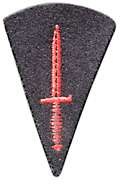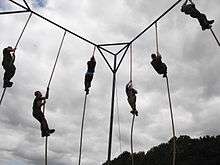All Arms Commando Course

The All Arms Commando Course (AACC) lasts for 13 weeks and is run by the Royal Marines at the Commando Training Centre Royal Marines (CTCRM), Lympstone. Members from any of the United Kingdom's Regular Armed Forces (e.g. personnel from units attached to the Marines) and overseas exchange personnel can attend to serve with 3 Commando Brigade (3 Cdo Bde RM). On completion of the course the successful candidate earns the right to wear the green beret, and to wear the "Commando Dagger" on their uniform. The Royal Marines expects that nearly half of the volunteers will drop out or be dismissed before completing the AACC.[1][2][3]
The course is open to both men and women. In 2002 Major Philippa Tattersall of the Adjutant General's Corps became the first woman to have successfully completed it.[4]
Background
The first formal commando training course was established at Achnacarry in 1942 and some elements remain exactly the same to this day, such as the "rope regain" and the "Tarzan course", designed to test the courage, agility and determination of candidates. Others have changed in times and distances, such as speed-marching and the endurance course. The specific tests which volunteers are put through are not as important as the fact that their fortitude should be tested to the limit. The basis of the commando ethos can be summed as unity (unselfishness), adaptability, humility (as in non-arrogance), high professional standards, fortitude and humour (cheerfulness in the face of adversity).[5][6][7]
Since the Second World War, all the Army Commando units have been disbanded leaving the Royal Marines Commandos to carry on the tradition. Nevertheless, these commando units are supported by a variety of non Royal Marines personnel. In the year 2000, over 1,000 British Army soldiers wore the green beret and supported 3 Commando Brigade. About 30 per cent of 3 Commando Brigade, performing vital support roles, were not Royal Marines in 2004, such as 29 Commando Regiment Royal Artillery and 59 Commando Squadron Royal Engineers.[8][9][10]
Course aims
To prepare Navy, Army or Air Force personnel for service with 3 Cdo Bde RM by developing the temperament, mental resolve, physical robustness and core military skills necessary in the demanding environment of expeditionary and littoral operations— All Arms Commando[1]
Course content
Volunteers attend a 4-week preparation course, prior to the AACC, which brings them from a broad range of backgrounds up to a common standard of basic skills and fitness needed to start the AACC. The AACC is for trained military ranks only and is not open to new recruits into the armed forces. Core military skills are covered during the AACC, including fieldcraft, tactics, patrolling, defence and section and troop level attacks. troop weapons, signals, map reading, navigation, first aid, health, hygiene and physical training. The course then covers the following Commando skills: amphibious assault drills, cliff assault drills, helicopter drills and small-unit tactics. The course concludes with a week-long confirmatory test exercise followed by "Test Week".[1][2]
Tests
During the course
The following Tests must be passed by the volunteers:[1][2][11][12]

Wearing boots, trousers and smock, carrying fighting order and personal weapon:
- 30 ft (9.1 m) rope climb
- Bottom Field assault course in under 5 minutes
- Fireman's carry, over 200m carrying own and colleague's equipment and weapon (combined weight of 62 lb (28 kg)), in 90 seconds
- Full regain over the water tank.
- 12-mile (19 km) load carry – at night, as a formed body carrying 69 lb (31 kg) marching order and personal weapon within, in 4 hours.
Commando Tests
Completed on consecutive days during the final test week:[1]
- Endurance Course – 2-mile (3.2 km) of cross country and water obstacles followed by a 4-mile (6.4 km) road run in 73 minutes carrying 21 lb (9.5 kg) fighting order and a personal weapon, followed immediately by a range shoot in a 25m range simulating 200m, in which 6/10 targets must be hit
- 9-mile (14 km) speed march – as a formed body in 90 minutes carrying 21 lb (9.5 kg) fighting order and personal weapon
- Tarzan Assault Course – in under 13 minutes carrying 21 lb (9.5 kg) fighting order and personal weapon
- 30-mile (48 km) cross-country march over Dartmoor under 8 hours carrying 21 lb (9.5 kg) fighting order and personal weapon.
Reserve forces commando course
There is also a reserve forces commando course run for members of the Royal Marines Reserve and commando units of the Army Reserve. The tests are the same as for the AACC above.[11][13] The Army Reserve was previously known as the Territorial Army (TA).[14]
References
- 1 2 3 4 5 International Defence Training 2014.
- 1 2 3 Army Jobs 2012.
- ↑ BBC 2001.
- ↑ BBC 2002.
- ↑ Saunders 1971, p. 35.
- ↑ King 2004, pp. 18,19,21.
- ↑ King 2004, pp. 9,15,23,25.
- ↑ King 2004, p. 6.
- ↑ Hunter 2000, pp. 6,267.
- ↑ Neillands 2004, pp. 418–419.
- 1 2 MoD/RE 2014.
- ↑ 131 Cdo Sqn 2014.
- ↑ Joseph 2014, pp. 33–35.
- ↑ BBC 2012.
Sources
- 131 Cdo Sqn (2014), Become a commando engineer without leaving your job (PDF), MoD/Army, retrieved 14 Oct 2014
- Army Jobs (2012). "All Arms Commando Course". British Army. Retrieved 14 Oct 2014.
- BBC (4 June 2001). "Woman fails commando course". BBC. Retrieved 24 October 2014.
- BBC (31 May 2002). "'Long, hard struggle' for green beret". BBC. Retrieved 14 October 2014.
- BBC (14 October 2012). "Territorial Army 'to be renamed the Army Reserve'". BBC. Retrieved 15 October 2014.
- Hunter, Robin (2000). True stories of the Commandos. Virgin Publishing. ISBN 978-0-7535-4053-4.
- International Defence Training (2014), All Arms Commando (PDF), Royal Navy, retrieved 14 Oct 2014
- Joseph, Ed (2014), Army Reserve Quarterly (PDF), MoD/Army, retrieved 14 Oct 2014
- King, Dr Anthony (2004). The Ethos of the Royal Marines (Report). University of Exeter.
- MoD/RE (2014). "Commando training". Ministry of Defence. Retrieved 15 October 2014.
- Neillands, Robin (2004). By Land and By Sea: The Story of the Royal Marine Commandos. Pen & Sword Books. ISBN 1-8441-5043-7.
- Saunders, Hilary St George (1971). The Green Beret. New English Library Books. ISBN 9780450010071.
External links
- Rope regain video
- Endurance course video
- 9 mile speed march video
- Tarzan course video
- 30 miler video